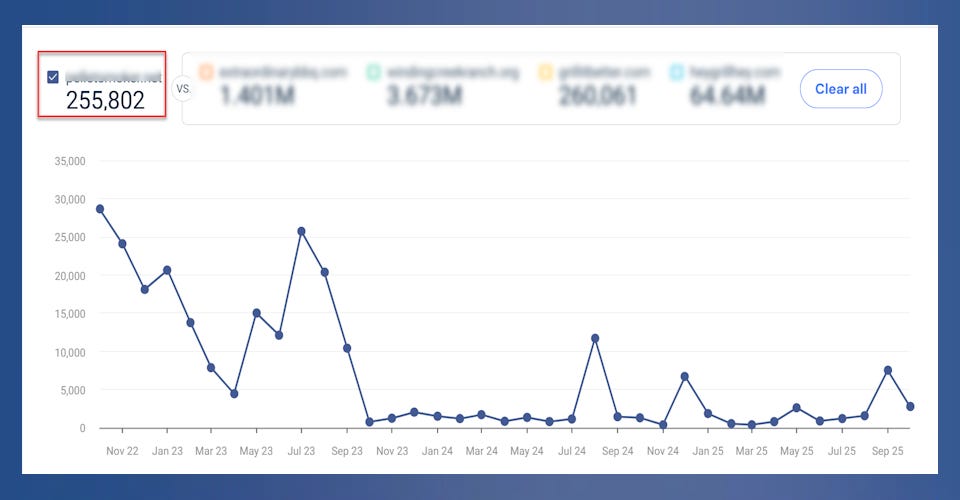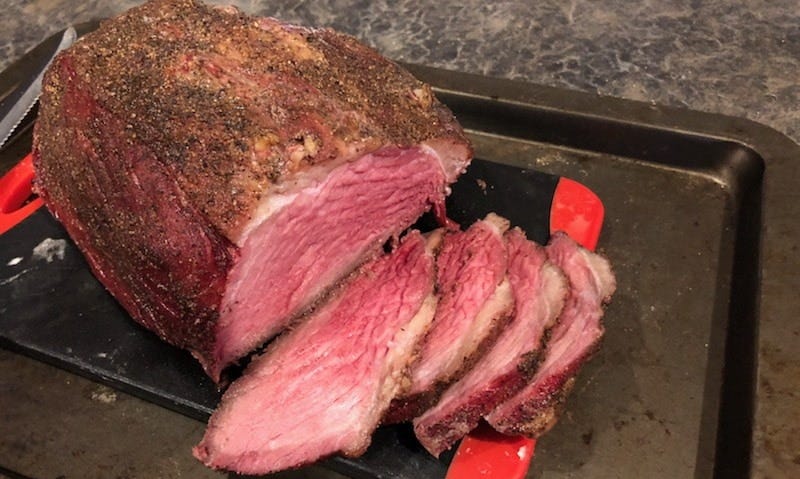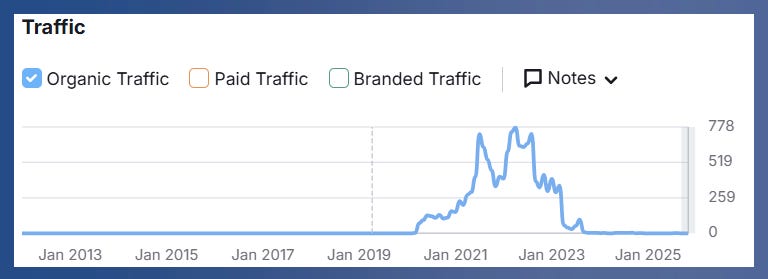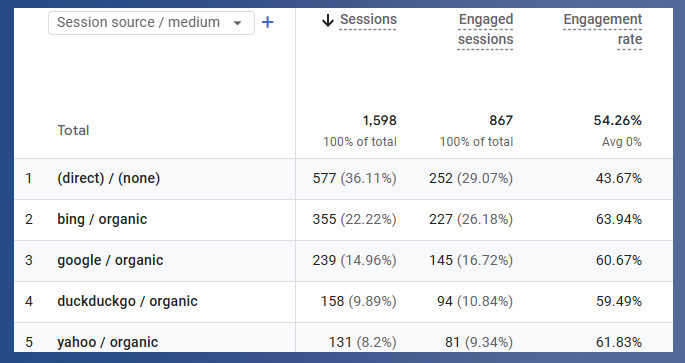The No Keyword SEO Strategy That Drove 1 Million Sessions.
If your SEO strategy is mapping content to keyword tool exports, you're toast.
This week’s #SEOForLunch is sponsored by The AI Search ReportI built a 40-page website that pulled in over 1 million organic visits over ~2 years. No keyword tools. No “fan out queries”, no volume filters or difficulty scores.
Just me, a pellet smoker, and a lot of meat.
While most people in 2020 and 2021 were binging Netflix and trying not to strangle their family during game night, I was in the backyard learning how to smoke ribs and brisket on my Traeger. After a handful of solid cooks, the marketer in me kicked in. I started documenting every smoke, taking photos, and quietly spinning up a little niche site around it.
I already had plenty of enterprise-level CPG and recipe-site experience, so I knew the space and how it worked. But this time, I ignored every “proper” SEO process. No keyword research spreadsheets. No export from a tool. This was also pre-AI Overviews and AI content spam, so I had the freedom to build around what real people actually needed, not what a tool said had 1,300 monthly searches.
Let’s get into the MEAT of the strategy. (No promises the dad jokes/analogies get any better from here on out.)
Thank you to this week’s #SEOForLunch sponsor: The AI Search Report
Your Weekly Briefing on AI Search + SEO
Google is shifting from blue links to AI answers. ChatGPT, Perplexity, Gemini, and YouTube are all part of the new search stack. If you want to stay visible across AI and traditional search, you need more than ranking tips.
Every week, Nathan Gotch breaks down the most important AI search updates, tests real examples, and shows how to turn them into practical SEO and content actions for your clients and sites.
The Proof Is In the Pudding Meat
Like every recipe postted on the internet, I’m going to start with the final dish. Then I’ll walk you through exactly how I pulled in over 1 million sessions with a 40 page site, including the shortcut that came back to bite me in the ass.
First, the annoying part. Because this was in 2020–2021, the site was tracked in old school Universal Analytics. When we were all forced into GA4, I lost the historical data. At the time, I was weirdly fine with it given how the site had been hammered. I will get into that story in a bit.
The good news for you is that I was still able to pull third party traffic and keyword estimates. So no, this is not a “keyword tools are trash” rant. It is proof that you do not have to start with keyword exports to build something that works.
BTW - the click estimates are low in these tools. I show you some real ad revenue details from sessions + ad impressions later in this post.
The Keyword Strategy So Easy Even Your Grandma Can Do It!
No advanced research. No 2,000 row exports. The only “trick” I used was a slightly spammy link play to build authority, which I do promise to share the juicy details.
The core keyword strategy is literally as simple as reading a label.
Picture this: you pull a mystery hunk of meat out of the freezer for dinner. You want ideas, so you head to Google. What do you type?
Most people search using whatever is printed on the label.
Not sure what cut you are holding? You look at that tiny sticker on the package. That is where the magic starts.
In my case, the package said something like “Beef Round Bottom Roast.” That exact phrasing becomes the seed. Once someone figures out the name of the cut, they head to Google (and now LLMs) and search:
[cut name] + recipe
So in this example: “beef round bottom roast recipe.”
I took it one step further. Since my whole angle was smoking meat on a pellet grill, I added “Traeger smoked” to all my recipes. No idea how much “search volume” these variations had but I knew how real people searched
I would do my usual smoking session, snap a few decent iPhone pics, and turn it into a post. One great meal for the family, one highly specific piece of content for the site.
So what happens when you combine intuitive, label-based queries, a simple WordPress install, and an iPhone camera? The Semrush chart for this single recipe shows how fast it started pulling in organic traffic.
The Fire That Really Added Smoke!
OK, the part you actually care about. Identifying valuable queries is half the battle. The other half is authority. Yep, those pesky inbound links.
The site did almost nothing in the first 6 months, so I knew I needed to inject some authority into it the same way you might inject marinade into a pork shoulder.
Here is what went down.
I stumbled across a link shortener (think Bitly) while doing competitor research for a client of mine. Unlike Bitly though, this tool used 301 redirects instead of 302s. That alone made my SEO brain light up. These redirects were passing ranking value!
The best part? Every link through this service was temporary. After a set period of time the redirect expired and the shortener URL could be reused.
So I dug in.
I reviewed hundreds of dead shortener URLs on sites that had used them in the past. I started with niche relevant sites that had broken shortener links pointing (now) to nowhere: recipe blogs, mom blogs, and a few recognizable cooking publishers.
Like any good idiot with a new toy, I got greedy. I started picking up links from places like upenn.edu, a few .gov sites, and some big news outlets (think WSJ/NYT).
Boom: instant access to 50-plus high authority and (mostly) relevant backlinks.
I “claimed” these links by grabbing the expired short URLs inside the shortener websites backend and repurposed them updating the redirect to point directly to my site.
I bet you can guess what happened next.
Traffic climbed to 50k-plus organic visits per month from what started as a backyard (COVID friendly) hobby. I threw AdSense on it, later swapped to Ezoic, and suddenly I was making close to $1k a month for smoking meat, feeding my family, and being a marketing dork.
I am pretty sure I am not supposed to share ad and click data publicly, but I do not use these platforms anymore, so to hell with it.
Even The Best Cooks Burn Food
When I discovered this loophole, I fully expected it to get patched and for the value to disappear fast.
Instead, I got about a year and a half out of it. I made some money, collected a lot of clicks, and had a good run.
Then the party ended.
I woke up one day and watched the ~50 keywords I was tracking fall off a cliff (yes, after traffic sky rocketed I started paying attention to keywords). Deep down, I knew exactly what happened. The shortener switched those links to 302s with an additional JavaScript redirect and my little SEO parade ended overnight.
Traffic dropped to a few hundred visits per day and kept sliding from there.
I was not surprised, but I was definitely bummed. It was a fun experiment while it lasted. I teased this story on LinkedIn almost a year ago and people loved it. Today you finally get the meat and potatoes behind the whole thing.
Round 2: Revival Time. Ha, Yeah Right.
Now that you are at the end of the story, you are probably thinking, “Nick, you could have easily revived this. The strategy clearly worked, you just needed new links to replace the authority you lost.”
You are not wrong. I even made a small attempt at a comeback. The content was solid and most of the smoking recipes had hundreds of 4 and 5 star ratings.
But I lost interest fast. My attention shifted to a new project you might have heard of, and the site sat there. At one point, I even offered a buddy 50% of any future revenue if he took it over. He did a bit more work, but ultimately, the site was toast.
The GA4 screenshot for this past October tells the full story. It is rough. Funny how of bing is the top referrer and I suspect most of that direct traffic are misattributed scraps of what use to be 1 million+ organic visits.
So what is the takeaway? Test. Push boundaries. Learn.
This was not a client site. I was not scamming users or serving garbage content. I simply tricked robots into thinking I was more authoritative than I really was and rode the wave until it crashed.
This kind of thinking and experimentation is what makes you stand out in this industry. And with the current job market, you might need even more of it.
If your takeaway is to find more loopholes for your client work… please do yourself a favor and unsubscribe. You need an SEO time-out!











